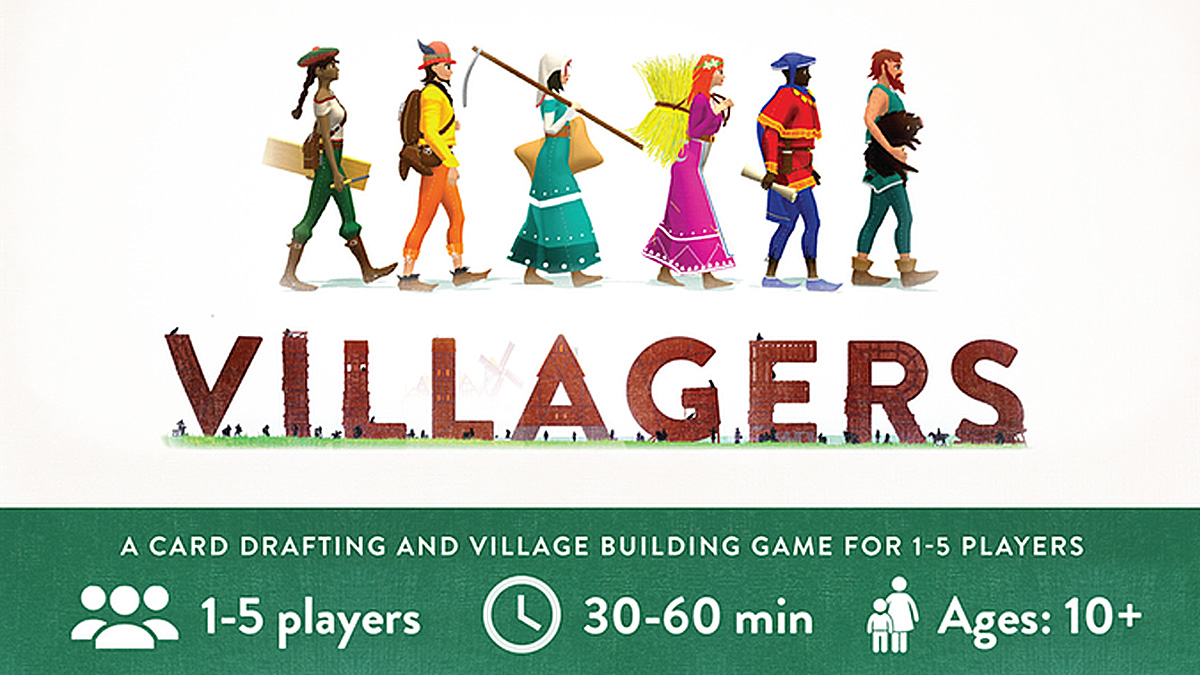
What is Villagers?
Villagers is a card drafting game created and illustrated by Haakon Garder, it is currently crowdfunding via Kickstarter and has already tripled its goal amount. In Villagers, players compete to design a successful village in a land not dissimilar to medieval Europe. The game can be played by between one and five players age 10 and up.
New to Kickstarter? Check out our crowdfunding primer, and visit our Kickstarter curated page for more projects we love.
Villagers Components
Note: My review is based on a prototype copy which may be subject to change before final copies are shipped. My prototype copy did not come with coins so example photos show coins taken from Small World.
The base game of Villagers contains:
- 131 Villager Cards
- 110 Coins (Various Denominations)
- 2 Market Cards
- 5 Player Aid Cards
- 5 Village Cards
- 21 Solo Mode Cards
- 1 First Player Card
- 1 Rulebook
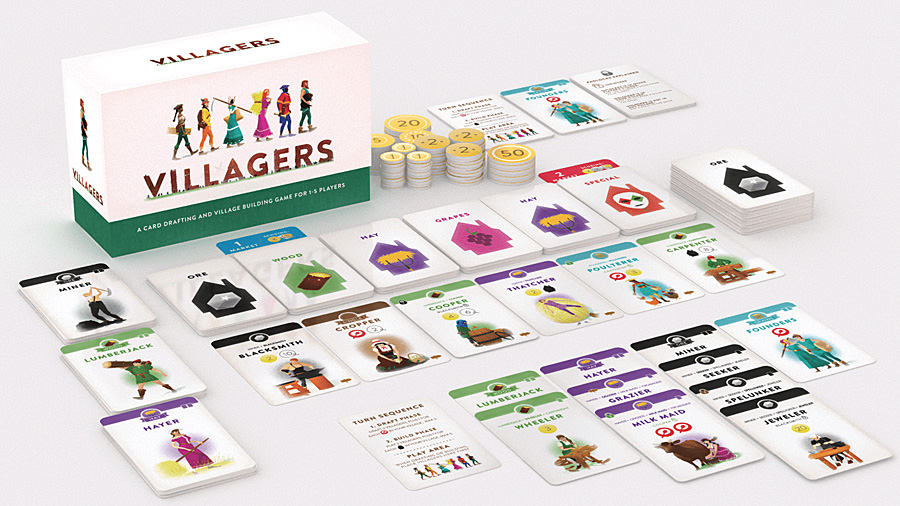
How Do You Play Villagers?
Setup
Setup differs slightly depending on the number of players in the game. It is also very different when playing solo against the game but here I’ll focus on a standard two to five player game for clarity.
- Identify the six Starting Road Villagers marked with a small brown sign in the bottom right-hand corner and place them face up in a line on the table.
- Place the 24 Basic Villagers face up into three separate stacks containing the 8 Miners, 8 Lumberjacks, and 8 Hayers.
- Give each player a Founders card and place it coin side up in the player’s Village. Each player should also receive a Player Aid and Village card.
- Give each player six 1-denomination coins and place the remaining coins in a Bank to the side of the gameplay area.
- Give the First Player card to whoever has lived in the same place longest (or decide who goes first however you choose).
- In a two or three player game, remove the villagers in the Wool and Leather Suits – these are marked with a 4+ symbol.
- Shuffle the remaining Villager cards and form six stacks above the six Road Villagers – each stack should contain twice as many cards as there are players.
- Add the Number One Market Card beneath the second stack and the Number Two Market Card beneath the sixth and final stack.
- After the stacks have been formed, deal out a starting hand to each player. In a four to five player game, each player receives five cards, in a three-player game each player receives six cards, and in a two-player game each player receives seven cards.
- Place the remaining cards in a pile to form the Reserve.
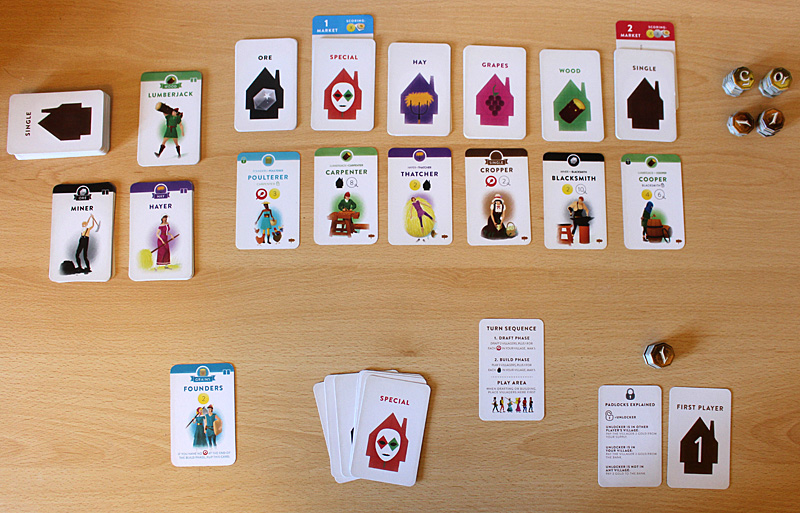
Gameplay
The main gameplay of Villagers is split into two alternating phases, the Draft Phase and the Build Phase which repeat for the length of the game, broken up once by the first Market Phase when the first Market Card is revealed. The game is over when all six card stacks have been emptied and the second Market Phase card has been revealed.
Draft Phase
During the Draft Phase, players take it in turns to draft villagers into their Play Area beginning with the player who currently holds the First Player card. They may either choose to draft face up villager cards from The Road or face down cards from the top of any of the stacks. All players begin the game able to draft two villagers, from the second draft phase and onwards, players may draft two villagers plus an extra one for every food (red bowl and spoon) symbol they have in their village, up to a maximum of five – your Drafting Limit. Villagers belong to one of nine different suits – Hay, Ore, Wood, Grains, Grapes, Wool, Leather, Single and Special. Most villagers need to be placed within Production Chains in your Village, this is something we will cover during the Build Phase.
When drafting, players put their drafted cards face up into their Play Area until every player has finished drafting, their new villagers are then added to their hand. Any time a card is drafted from The Road, the top card from the left-most stack is brought down to replace it, this gradually depletes the stacks from left to right. If a Market Phase card has been revealed, play continues through the next Build Phase and the Market Phase is triggered before the next Drafting Phase begins.
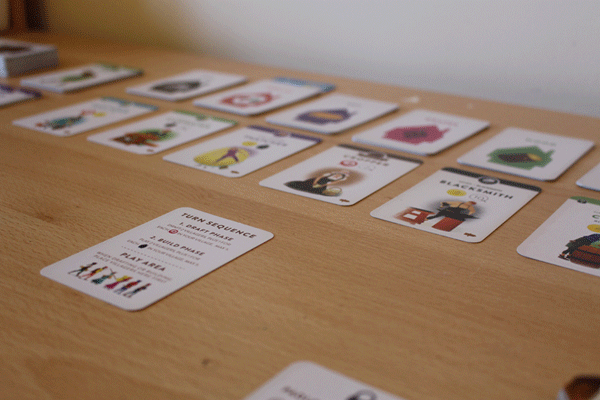
Once every player has finished drafting, the Road is updated. First, any villagers on the Road with coins on them are discarded. These empty space are then filled with new face-up villagers from the Reserve (if the Reserve is empty use the cards from the left-most stack, and if all the stacks are empty, no new cards are added). Finally, place a coin on top of each villager on the Road.
In a two-player game, no coins are used during updating the Road, instead, all the Road villagers are removed and replaced with six new cards from the Reserve after each Draft Phase.
Build Phase
The Build Phase now begins. Beginning with the first player, each player now places villagers from their hand into their Village. Every player can place two villagers into their village, plus an additional card for each Builder (black house) symbol already in their Village, up to a maximum of five – this is your Build Limit. Once a villager has been placed in the Village, it is final and they cannot be removed. Players place all their villagers before passing to the next player.
Most villagers must be placed within Production Chains. Production Chain information is shown at the top of these villager cards and cards must be placed in order although the chain does not have to be completed during a single phase. Only the bottom-most card of a Production Chain is scored at the end of the game but longer Production Chains usually wield greater rewards.
The top of a Production Chain is formed by a Basic Villager – usually either a Lumberjack, Hayer, or Miner. These Basic Villager cards can be taken from the supply stacks when required and are free cards which do not count toward your Build Limit. The Founders also count as Basic Villagers and can support two Production Chains. The Grapes, Wool, and Leather suits are different because their Basic Villagers are contained somewhere in the main deck and must be drafted in order to form these special types of Production Chains.

Another limitation on Village building is the padlock symbol. These symbols appear on certain cards to indicate that the card must be unlocked by another villager card before a player can place it in their Village. Cards are unlocked in three ways depending on where the Unlocking Villager is.
- If no players currently have the Unlocking Villager, the player placing the locked villager must pay two coins from their supply to the Bank.
- If another player has the Unlocking Villager, the player must place two coins from their supply onto that card in the opposing player’s Village.
- If the current player has the Unlocking Villager in their own Village, they take two coins from the Bank and place them on the Unlocking Villager card.
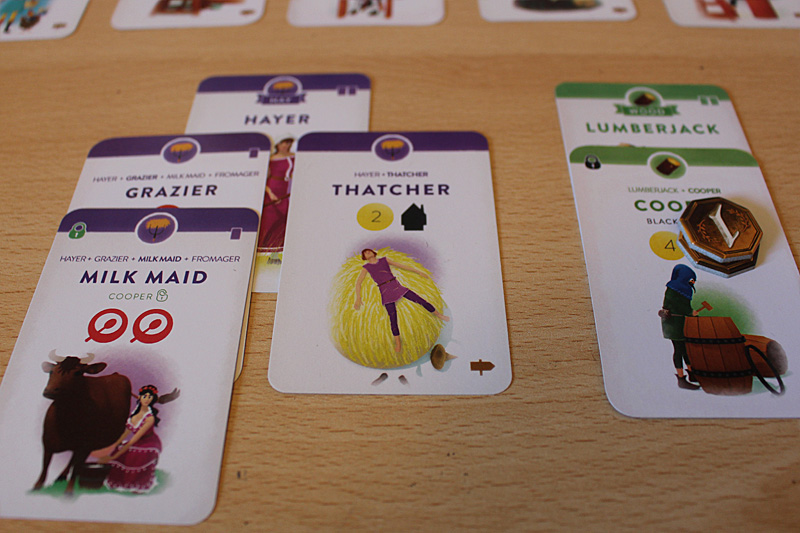
Single villagers do not require production chains and can be placed by themselves in the Village. Finally, there are Special Villagers. Each Special Villager has a skill and they can often be used to help complete Production Chains. Special Villagers include the Monk, Tinner, Smuggler, and Apprentice.
Once every player has placed cards equal to their Build Limit into their Village, the First Player card is moved to the next player and another Drafting Phase begins unless either of the Market Phase cards were revealed during the previous Drafting Phase in which case a Market Phase begins.
First Market Phase
The first Market Phase is triggered when the second stack has been completely emptied and the first Market Card has been revealed – it takes place after the next Build Phase has been completed. At this point, all players count up the amount of gold printed on the cards in their Village plus any coins placed on villagers from unlocking padlocks on other cards. They then take that amount from the Bank and add it to their supply. Only gold coins are counted in this first Market Phase and remember that only the bottom card of a Production Chain is scored – all the cards above it which have been partially covered are not counted.
Final Market Phase
The second Market Phase is triggered when the sixth and final stack has been completely emptied and the second Market Card has been revealed, after the final Build Phase. As with the first Market Phase, players add up all the gold and coins in their Village and take that amount from the Bank, however, in this phase silver coins are also counted. These can come from many villagers and give coins according to the condition stated on the card. For example, the Ore Muler gives four gold for every two ore-suit villagers in the Village, and the Food Seller gives three gold for every food symbol in the village.
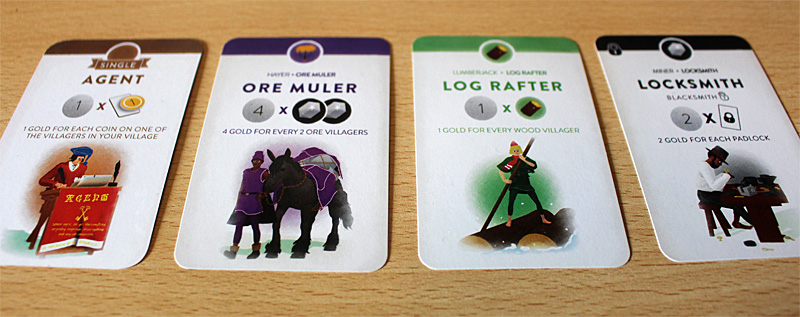
Winning
Once the second Market Phase is complete, the game is over. All players then count up the gold in their supply and the player with the most gold is the winner. In the case of a tie, the player with the most cards still in their Hand is the winner.
Why Should You Play Villagers?
Villagers is a fun game with excellent replay value because with so many potential combinations of cards on the table at any one time, every game will be different. It took a while for us to get the hang of it all, but once we did we found that the game has a great flow and works beautifully. We found that the game had a steeper learning curve than many card games. There’s a lot to take in on your first play and a lot to remember, from Drafting and Build Limits to Production Chains, unlocking cards, and special abilities. This is not a game I’d recommend for beginners. However, despite all its different phases, card types and rules, there’s nothing superfluous here – everything about Villagers feels neat, clean, and well thought-out, and experienced tabletop gamers will find a lot to love. The artwork is beautiful too and I loved the use of color and design on every card.
The game is highly strategic with no die-rolling or other elements of chance forming part of the gameplay, the only thing that comes down to luck is which cards come out when. This does mean that younger players are likely to struggle as there is no chance element to level the playing field to their advantage – everything has to be thought out, cards maximized, and strategies put in place to utilize what you have to your advantage. It’s one of the few games we haven’t played with our eight-year-old son who’s something of a tabletop gaming whizz – there’s just too much strategy to keep in your head at once for him right now.

Villagers also has the potential to be deeply frustrating, mostly because of its one chance elements. In our games, we’d often find ourselves struggling to complete Production Chains because a certain card we needed just wouldn’t appear, leaving us unable to finish a plan. This forces you to think on your feet during every round and maximize what you have available to you at the moment in addition to making long-term plans. Whatever plan you go into the game with, you’ll probably need to change it at least three times before the end! This might not always be a bad thing though. In fact, in the game where nothing went right for me and I could never get the cards I needed to complete my initial goals, I ended up winning with my biggest score.
Villagers has already reached over triple its Kickstarter goal, and the production team behind it have experience bringing a crowdfunded game to life (their previous game Great Scott! is now on shelves) making this one a good prospect, I’m already looking forward to playing a finished edition complete with coins. It’s not a game for the whole family but it will go down well with those looking for a challenge.
It takes a village to raise a child and it takes a table full of gamers to raise a village. If you’re up to the task, funding for Villagers is now open on Kickstarter.
GeekMom received this game for review purposes.



